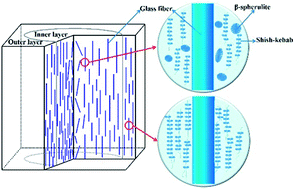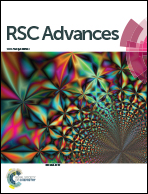Simultaneous improvement of strength and toughness in fiber reinforced isotactic polypropylene composites by shear flow and a β-nucleating agent†
Abstract
Inspired by the hierarchical structure of natural plants with a highly oriented and ‘stiff’ outer skin and an isotropic or poorly oriented ‘soft’ inner core, such as bamboo and sugarcane, we demonstrated an analogous hierarchical structure in glass fiber reinforced isotactic polypropylene (GF/iPP) composites with the aid of a β-nucleating agent and an oscillatory shear injection molding technique. The synthetic hierarchical structure consisted of composite assemblies of glass fibers and a semi-crystalline matrix with self-reinforced crystalline shish-kebabs (α-crystals) throughout the molded part. It was found the outer layer was dominated by highly oriented glass fibers and shish-kebabs, while the inner layer contained less oriented glass fibers and shish-kebabs but a large population of β-crystals. As a result, the strength and toughness of the final GF/iPP parts were simultaneously improved (tensile strength was increased by 19.3 MPa and the impact toughness by two folds) compared to the conventional injection-molded GF/iPP parts. The approach exhibited a new pathway to further optimize the properties of GF/iPP composites through structure manipulation.


 Please wait while we load your content...
Please wait while we load your content...